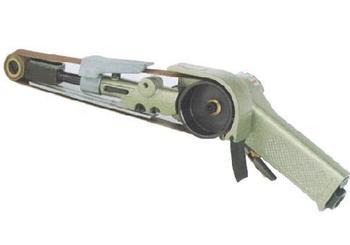 Pneumatic tools are a type of equipment that operates using compressed air, driving an air motor to generate mechanical energy. These tools are typically designed to be compact and lightweight, making them ideal for mobile or on-the-go use. This balance between performance and portability is achieved through advanced structural design, precision manufacturing, high-quality materials, and rigorous heat treatment processes. As a result, pneumatic tools not only offer greater ease of use but also deliver superior performance compared to many electric power tools.
One of the key advantages of pneumatic tools is their versatility in operation. They can perform a wide range of functions such as rotation, reciprocation, swinging, and impact. Additionally, adjusting speed and output power is straightforward—simply by controlling the air supply valve and regulating the pressure. Pneumatic tools also offer a broader speed range, from 100 rpm up to 70,000 rpm, making them suitable for various applications.
Another benefit is their favorable weight-to-volume ratio. For the same level of power output, they are generally smaller and lighter than electric tools. Moreover, they don’t overheat during prolonged use, and even under overload conditions, they will simply stop rotating without causing damage. Once the load is removed, they resume normal function immediately.
In terms of motion, pneumatic tools utilize piston movement, which is more efficient and reliable compared to the cam mechanisms used in some power tools. This makes them particularly well-suited for tasks requiring repetitive or precise motion.
Pneumatic tools also excel in environmental adaptability. They are highly resistant to water and do not produce sparks, making them safe for use in potentially explosive environments like coal mines or oil fields. Although they require regular maintenance—such as dust removal, moisture control, and lubrication—they can operate in harsh conditions and are ideal for large-scale production lines.
From an economic perspective, while the initial cost of power tools may be lower, long-term energy costs and maintenance expenses tend to be higher. In contrast, although pneumatic tools require an initial investment in an air compressor system, they are more cost-effective over time due to lower energy consumption and less frequent repairs. Plus, their lighter weight makes them more comfortable for extended use, significantly improving overall work efficiency.
Pneumatic tools are a type of equipment that operates using compressed air, driving an air motor to generate mechanical energy. These tools are typically designed to be compact and lightweight, making them ideal for mobile or on-the-go use. This balance between performance and portability is achieved through advanced structural design, precision manufacturing, high-quality materials, and rigorous heat treatment processes. As a result, pneumatic tools not only offer greater ease of use but also deliver superior performance compared to many electric power tools.
One of the key advantages of pneumatic tools is their versatility in operation. They can perform a wide range of functions such as rotation, reciprocation, swinging, and impact. Additionally, adjusting speed and output power is straightforward—simply by controlling the air supply valve and regulating the pressure. Pneumatic tools also offer a broader speed range, from 100 rpm up to 70,000 rpm, making them suitable for various applications.
Another benefit is their favorable weight-to-volume ratio. For the same level of power output, they are generally smaller and lighter than electric tools. Moreover, they don’t overheat during prolonged use, and even under overload conditions, they will simply stop rotating without causing damage. Once the load is removed, they resume normal function immediately.
In terms of motion, pneumatic tools utilize piston movement, which is more efficient and reliable compared to the cam mechanisms used in some power tools. This makes them particularly well-suited for tasks requiring repetitive or precise motion.
Pneumatic tools also excel in environmental adaptability. They are highly resistant to water and do not produce sparks, making them safe for use in potentially explosive environments like coal mines or oil fields. Although they require regular maintenance—such as dust removal, moisture control, and lubrication—they can operate in harsh conditions and are ideal for large-scale production lines.
From an economic perspective, while the initial cost of power tools may be lower, long-term energy costs and maintenance expenses tend to be higher. In contrast, although pneumatic tools require an initial investment in an air compressor system, they are more cost-effective over time due to lower energy consumption and less frequent repairs. Plus, their lighter weight makes them more comfortable for extended use, significantly improving overall work efficiency.Guangdong Kinen Sanitary Ware Industrial Co.,Ltd. , https://www.kinengroup.com
